Camera comparison: HTC One (M8) vs Samsung Galaxy S4, Galaxy Note 3, iPhone 5s, LG G2, Nexus 5, Nokia Lumia 1520, Sony Xperia Z1S
- iPhone 6 vs iPhone 6 Plus vs iPhone 5s vs Galaxy S5 vs LG G3 vs Lumia 1520 vs Xperia Z2 vs HTC One (M8) Camera comparison
- Samsung Galaxy Note 4 vs iPhone 6 vs iPhone 6 Plus vs Sony Xperia Z3 vs LG G3 vs Galaxy S5 vs Galaxy Note 3 Camera comparison
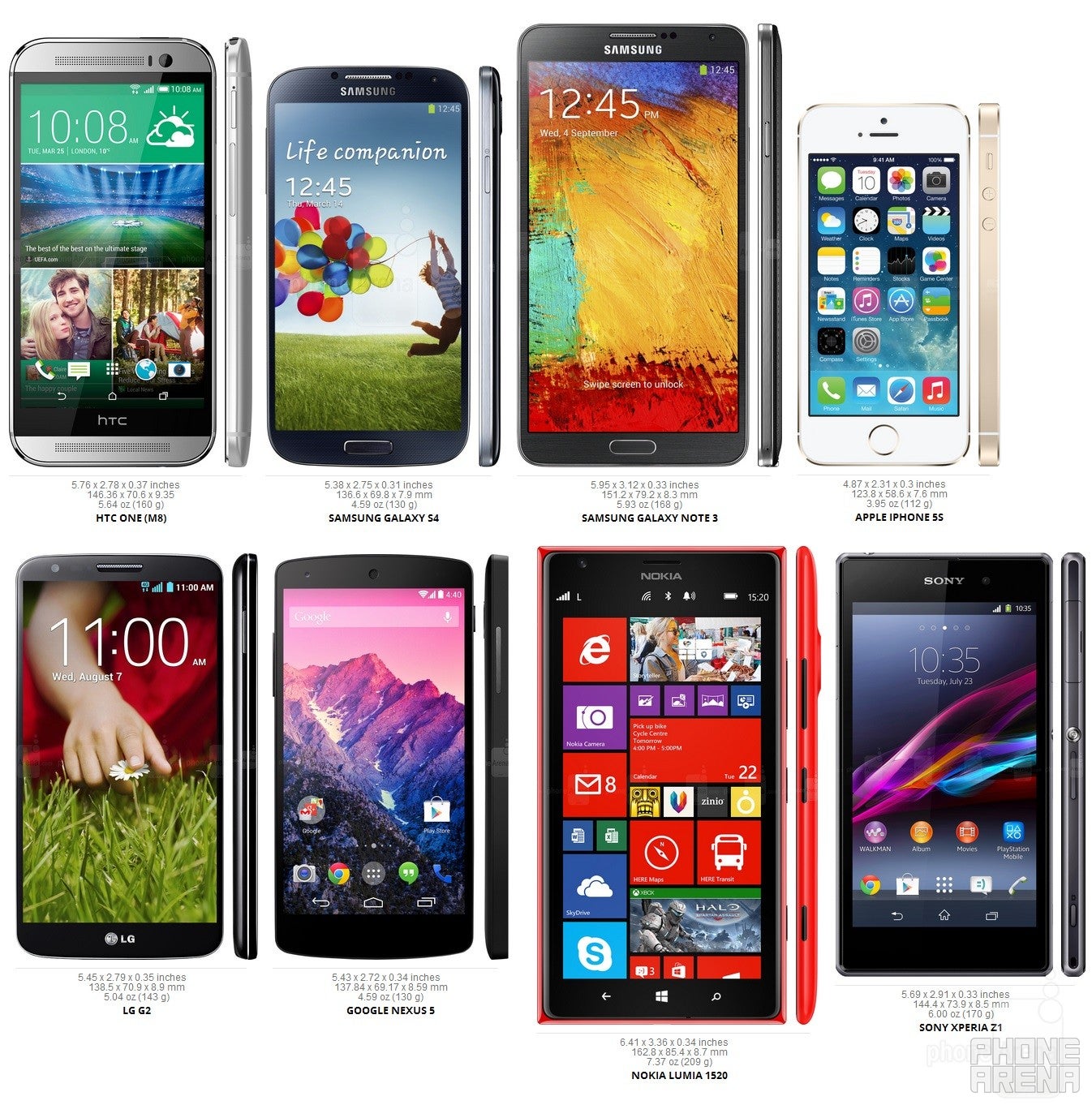
Introduction
Now, over a year later, it looks as if history is on the verge of repeating itself. HTC just took the veil off of the all new HTC One (M8), and its most peculiar feature is its much-touted Duo Camera. The latter consists of two cameras – an UltraPixel camera that is technically very similar to the one found on last year's model and a secondary unit to capture “depth information”. Thanks to the tandem, the photos can be post-processed for an emulated shallow depth of field – photos that look as if they have been taken with a professional camera.
But in reality, what will photos from the new HTC One's camera look like without the fancy after-effects applied? Could HTC's UltraPixel camera finally be a worthy rival to the cameras on today's high-end smartphones? Well, we're about to find out. We took the time to bring you this full-on camera comparison starring the new HTC flagship and some of the best smartphones in existence – the Galaxy S4, Galaxy Note 3, iPhone 5s, LG G2, Nexus 5, Nokia Lumia 1520, and the Sony Xperia Z1S.
Colors
As for the rest of the bunch, we'd rank the Samsung Galaxy S4 and the LG G2 the highest, although they aren't leading by much. Colors in the photos by these two are very close to reality, and what's more important, color accuracy is retained across scenes. In contrast, the Nokia Lumia 1520 takes awesome photos in some cases, yet throws the color balance out of the window in others. Photos by the iPhone 5s represent a scene that is warmer and brighter than what it looks real life, but as a whole, its photos are very eye-pleasing. We were expecting for the Galaxy Note 3's images to be as accurate as those by the S4, yet strangely, its photo turned out slightly more yellowish than they should have. Still, they're still pretty good-looking. The Sony Xperia Z1S produces great photos, although there might be some excessive color boost in some of them. The only not-so-great performer is the Google Nexus 5, which constantly produced overly warm, yellowish photos across the outdoor scenes in our testing.

Details
The Nokia Lumia 1520 is our favorite when it comes to amount of captured detail. It produces awesome, great-looking shots, exposing lots of visual information when viewed at full size. Behind it is the Sony Xperia Z1S, which also captures very detailed images, but the digital artifacts that can be seen once you zoom in on a photo aren't pretty. The Samsung Galaxy S4, Galaxy Note 3, and LG G2 (all featuring 13-megapixel resolution) all preserve about the same level of details in their photos, and as a matter of fact, the results are only slightly inferior when compared to the images by the 20-megapixel Lumia 1520 and Z1S. Photos from the iPhone 5s are comparable to those from the Google Nexus 5 (both feature 8-megapixel cameras). The former's image are sharper, but a tad noisier, while the latter's photos are with softer details, but less noise.
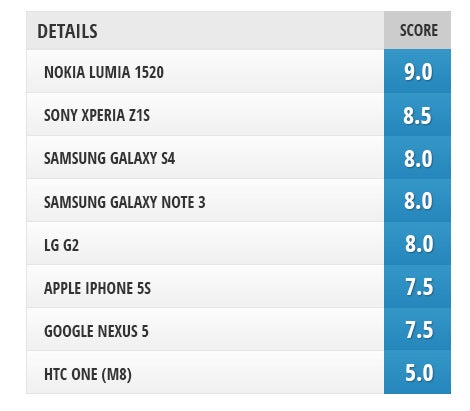
Indoor (low-light)
Indoor settings are traditionallychallenging environments to take photos in, especially when there'slack of sufficient lighting. The 2013 HTC One, in particular, almostalways delivered poor results in the indoor stage of our previouscamera comparisons. The new HTC One, however, seems to perform betterthan its predecessor. Its indoor shots aren't the most detailed (ofcourse), but they are lively looking, with sufficient exposure. Sure,there's some noise in the darker shots, but that should be expected.The new dual LED flash provides a good amount of light even at adistance of 7 feet from the subject, and its use doesn't have adetrimental effect on the image's color balance.
As of the rest are well capable oftaking great photos if the subject is well illuminated. In dim light,however, they start behaving differently. The LG G2, iPhone 5s, andthe Galaxy 4 will manage to produce a decent photo even if you chooseto manually switch the flash off, while the rest will leave the scenedark. With the flash on, best results should be expected from theSony Xperia Z1S, Lumia 1520, Samsung Galaxy Note 3, and the iPhone5s, although the rest of the phones can also produce a decent imageeven at a distance of 7 feet away from the subject.
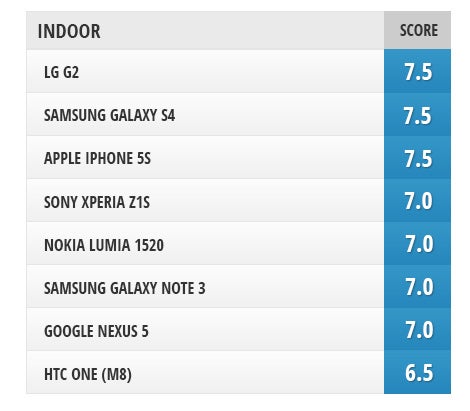
Night
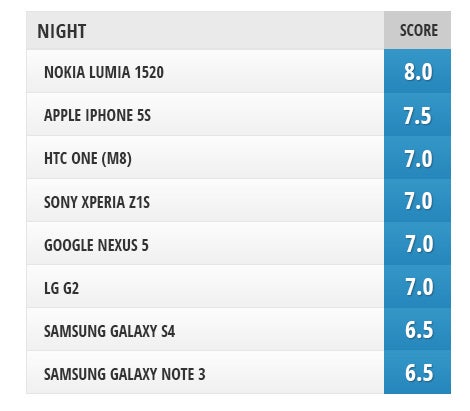
Video
We're happy to report that the new HTCOne takes really good 1080p videos with its camera. Footage is clear,detailed, stable, and with excellent stereo sound. Night videos,however, look much worse than the ones taken in broad daylight, witha fair amount of motion blur and easy-to-spot digital noise.
Overall, the best phone for takingvideos out of the bunch is the iPhone 5s. Its video is very smoothand stabilized really well by the camera's software. Yes, even atnight. The sound in the phone's videos, on the other hand, is ofbelow average quality. The Samsung Galaxy Note 3 is a close second,followed by the Galaxy S4. Their videos are very detailed andsurprisingly smooth at night, with good stereo sound and tolerabledigital noise. Next up we have the Xperia Z1. Its video quality isaverage, both in good and poor lighting, with sufficiently loud soundlevel. The LG G2 impressed us with its daytime video quality, but atnight, the phone fails miserably, producing videos with more motionblur than we can tolerate. Sound isn't stellar either as it is overlydigitized. Last on the ladder stands the Nokia Lumia 1520. Itsdaytime videos are often under- or overexposed, while the night onesare more noisy than we wish they were. Also, the sound is terrible.
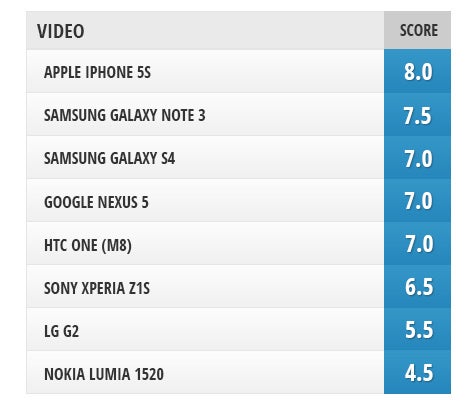
Conclusion
Yet truth to be told, the competition is still ahead of HTC when it comes to camera quality. Even the Galaxy S4, which has been around for over a year now, beats the new One in our test with its higher-res, 13MP camera. Samsung's former flagship produces photos and videos of very high quality even by today's standards. Similar words can be said about the LG G2 and the Galaxy Note 3 as well. With their 13MP snappers, they can easily capture a pretty picture under most lighting conditions.
The iPhone 5s and its 8MP camera serve as a proof that a higher pixel count doesn't guarantee better photos and videos. Apple's smartphone is still among the best phones to shoot with, regardless of the time of day. Results from the Nokia Lumia 1520 and the Sony Xperia Z1S kind of prove the opposite – both pack 20MP cameras, yet their advantage over other high-ends is usually slight, if not negligible. As for the Google Nexus 5, the odds in this comparison weren't in its favor, yet it performed respectably in most tests. While its camera is not the best we've ever taken for a spin, it is perfectly capable of meeting the needs of the average smartphone owner.






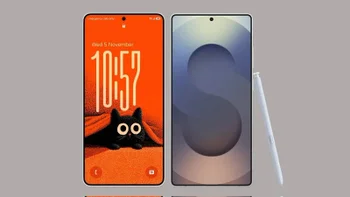


![A new Android bug is making it impossible to install new apps. Are you affected? [UPDATE]](https://m-cdn.phonearena.com/images/article/176703-wide-two_350/A-new-Android-bug-is-making-it-impossible-to-install-new-apps.-Are-you-affected-UPDATE.webp)


Things that are NOT allowed:
To help keep our community safe and free from spam, we apply temporary limits to newly created accounts: